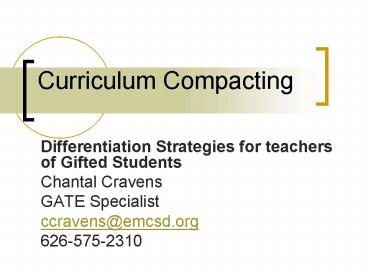Curriculum Compacting - PowerPoint PPT Presentation
1 / 20
Title:
Curriculum Compacting
Description:
Some get 'free time' which they enjoy, but without thoughtful planning, this ... (Gifted kids have 'holes' in their learning too.) Who gets pre-tested? All or some ... – PowerPoint PPT presentation
Number of Views:221
Avg rating:3.0/5.0
Title: Curriculum Compacting
1
Curriculum Compacting
- Differentiation Strategies for teachers of Gifted
Students - Chantal Cravens
- GATE Specialist
- ccravens_at_emcsd.org
- 626-575-2310
2
Compacting
- High-ability or high-achieving students are
frequently asked to participate in practice
exercises or instruction that they have
previously mastered. - Curriculum compacting is a process to
"streamline" and modify the grade-level
curriculum by eliminating material that students
have previously learned.
3
Why?
- Less repetition of previously mastered material
can result in more learning for some students.
- Students who already know the material can face
boredom, depression, inattentiveness, and
underachievement, and may become discipline
problems in their classrooms.
4
How Does It Work?
- In the curriculum compacting process, a form
entitled the Curriculum Compactor can be used by
teachers to guide the compacting services
provided to the students. - Teaching Young Gifted Children in the Regular
Classroom p. 55 - Differentiating Instruction-p. 142
- http//www.sp.uconn.edu/7enrcgt/sem/semart08.html
5
Pre-assess
- Students report being pre-tested in spelling and
math. - Some express frustration because they still end
up doing what everyone else does. Some get free
time which they enjoy, but without thoughtful
planning, this time becomes Academic Down-Time.
6
The following 3 steps are involved
- Defining the goals and objectives of a particular
unit/segment. - Documentation of mastery most of learning
outcomes. (scores, work samples, etc.) - Providing replacement options that enable a more
challenging and productive use of the student's
time - Teaching Young Gifted Children in the
Regular Classroom - p. 47 sample compacting forms
- Differentiating Instruction-p. 142
- http//www.sp.uconn.edu/7enrcgt/sem/semar
t08.html
7
Okay, what do I use for pre-tests?
- Unit pretests, or end-of-unit tests that can be
administered as pretests are ready made for this
task, especially when it comes to the assessment
of basic skills. - Pre-testing enables the teacher to document
proficiency in specific skills, and to assess
weak spots as well. - (Gifted kids have holes in their learning
too.)
8
Who gets pre-tested?
- All or some
- Although this may seem like more work for the
teacher, it provides the opportunity for all
students to demonstrate their strengths or
previous mastery in a given area.
9
Online Resources on Tiered Assignments
- Tiered Assignments for Kindergarten
http//webtech.cherokee.k12.ga.us/littleriver-es/e
williams/tieredassignmentskindergar.htm - Tiered 3rd grade literature study
http//webtech.cherokee.k12.ga.us/littleriver-es/e
williams/Tieredassignmentelementsofastory.htm
10
Considerations
- Great care should be taken to select activities
and experiences that represent individual
strengths and interests rather than the
assignment of more-of-the-same worksheets or
randomly selected kits, games, and puzzles.
11
Motivation and Underachievement
- When some previously bright but underachieving
students realized that they could both economize
on regularly assigned material and "earn time" to
pursue self-selected interests, their motivation
to complete regular assignments increased. As one
student put it, "Everyone understands a good
deal!"
12
(No Transcript)
13
Listing Objectives/Standards
- First, list the objectives for a particular unit
of study. - Teaching Young Gifted Children in the Regular
Classroom p. 55
14
Documentation of Mastery
- Teachers should detail the pretest vehicles they
select, along with test results. - Level of Mastery____________
- How demonstrated________ date___
- The pretest instruments can be formal measures,
such as pencil and paper tests, or informal
measures, such as performance assessments based
on observations of class participation and
written assignments.(You can attach these to
your cover sheet-essay, photos, video,
multimedia, etc.)
15
Specific Documentation
- Specificity is extremely important, depending on
the subject. Recording an overall score of 85 on
ten objectives, for example, sheds little light
on what portion of the material can be compacted,
since students might show limited mastery of some
objectives and high levels of mastery on others.
16
Filling in the holes
- The child may be asked to sit in on whole group
lessons on an area in which they demonstrate a
need or weakness.
17
Providing Acceleration and Enrichment Options
- The final phase of the compacting process is
based on cooperative decision making and
creativity on the parts of both teachers and
students. - Efforts can be made to gather enrichment
materials from classroom teachers, librarians,
media specialists, and content area or gifted
education specialists.
18
Enrichment
- Materials may include self-directed learning
activities, instructional materials that focus on
particular thinking skills, and a variety of
individual and group project oriented activities
that are designed to promote hands on research
and investigative skills.
19
Strengths and Preferences
- The Interest-A-Lyzer (Renzulli) provides profiles
of general categories of student interests. - www.gifted.uconn.edu/3summers/pdf/Interest-A-Lyzer
.pdf - (free download)
- learning styles http//members.shaw.ca/priscilla
theroux/styles.html
20
Go Forth and use your books!
- Teaching Young Gifted Children in the Regular
Classroom is full of great ideas for working with
students in the Primary grades, very user
friendly. - Curriculum Compacting is in Chapter 3 (page 47
and 55 have sample Compactors and planning tools) - I like the Tic Tac Toe Menu found on page 44 and
53. - Chapter 10- Social and Emotional Needs
- Differentiating Instruction, Diane Heacox
- -p. 137-143 Curriculum compacting
- -p.125 Managing Differentiation































